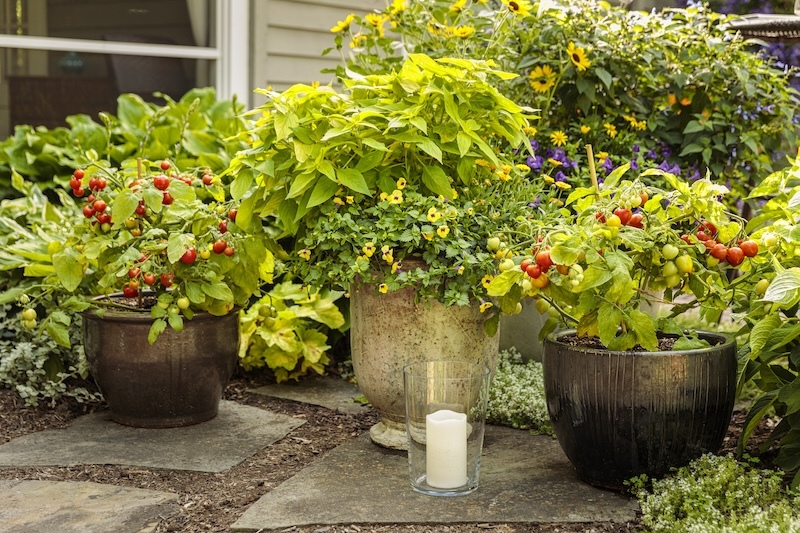Tomatoes may be the most grown food crop in the home garden. There is a variety to suit everyone's taste and growing space. Tomatoes are in the Nightshade family, which includes other garden favorites like peppers, potatoes, and eggplant. To grow a successful crop of juicy tomato fruits, plants will need full sun (at least 6-8 hours) and nutrient-rich soil that is moderately moist but well-draining.
Most tomato varieties will begin to bear fruit by the beginning of July depending on your regional growing conditions. Tomato starts can be planted out when the nighttime temperatures are consistently above 50 degrees F (10 C). While this may be in mid-March for states in the South, Coastal areas might not see warm enough temperatures until Mother’s Day or even into the beginning of June. Gardeners with shorter growing seasons can select tomatoes bred to ripen early or can provide cold frames, cloches, or low polytunnels to extend the growing season by a few weeks on either end.

Shrubs To Plant With Tomatoes
Tomatoes have deep root systems that seek out and extract moisture during periods of heat and drought, but this makes them a bit tricky to grow alongside other plants with formidable root systems. Tomatoes do not grow well in established shrub borders. Not only do the plants compete for moisture and nutrients, but any shade from taller or wider shrubs will greatly reduce the vigor and fruiting of the tomatoes. Additionally, most shrubs will not tolerate the heavy fertilization that tomatoes require through the growing season.
Perennials To Plant With Tomatoes
Perennial herbs and other shallow-rooted ornamental plants will happily grow alongside tomatoes. Flowering perennials such as rudbeckia, shasta daisy, and dahlias attract beneficial pollinators from mid-summer to fall just when tomatoes are producing heavy crops of fruit. Even though tomatoes are more reliant on wind for pollination, having more pollinators in the garden helps to spread the pollen and may also attract beneficial predators to keep insect pests in check.
Chives, tarragon, and oregano have shallow roots that rarely compete with tomatoes for nutrients and moisture. Their spreading nature allows them to be used as living mulch, which helps the soil retain moisture longer and suppress annual weeds through the growing season.
Annuals To Plant With Tomatoes
Annuals that love full sun exposure and rich, moist soil are easy to grow alongside tomatoes. Some of the best choices are basil, peppers, and pole beans. Legumes, like pole beans and peas, are capable of fixing nitrogen in the soil and can be trained vertically on poles or trellising, saving garden space. They also have a similar harvest time as tomatoes.
Ornamental and edible flowers such as nasturtium, cosmos, and marigolds look lovely and can attract and trap insect pests, such as black, green, and white aphids. Plant these catch crops away from tomatoes or any other susceptible crop to keep pest levels low.

Best Companion Plants For Tomatoes in Containers
Most types of tomatoes can be successfully grown in containers. Many containers are suitable, including 5-gallon or larger buckets, decorative pots, and even trash cans modified with plenty of drainage holes at the bottom. As long as there is plenty of room for root growth all season long, any container will work.
Smaller varieties of patio and cherry tomatoes can add interest and texture to a seasonal color container. Combine a patio tomato as the spiller with upright vinca, calibrachoa, and sweet alyssum for a showy and informal planter. The tomatoes can be harvested all summer and add bright color to a container arrangement.
Keep in mind that tomatoes in pots will grow slightly smaller than those in the ground and will require watering and fertilizing regularly. A weekly feeding with a diluted liquid fertilizer will keep the plants looking good and producing all season long.

Plants Not To Grow With Tomatoes
Tomatoes are part of the nightshade family, which also includes potatoes, eggplant, and peppers. This family of plants are susceptible to bacterial and fungal blights that often appear seemingly overnight. Planting tomatoes with potatoes is not recommended as these nightshade members can transfer diseases to one another. Interestingly, Tobacco Mosaic Virus can be transmitted to tomatoes by hands that are not washed between smoking a cigarette and working with tomato plants. Corn plants also share some of the same pests as tomatoes like beetles and cutworm grubs.
Some plants are not compatible with tomatoes and can stunt their growth and fruiting. Brassica family plants like cabbage, kohlrabi, or brussel sprouts should be grown in a separate area. The herb dill also stunts the growth of tomatoes after it is fully grown and at the flowering stage. As is the case for many other plants, tomatoes are sensitive to the chemical released by walnut trees and should not be grown near these trees.
Best Plants To Grow With Tomatoes
Tomatoes grow best when they are combined with other garden plants that can aid in pollination, such as flowering perennials. The best companions also have shallow root systems that do not compete for moisture and nutrients in the soil. Try using certain annuals, like marigolds and nasturtium, as a catch crop to reduce insect pests on your tomatoes.
 |
Author Robbin Small - Published 4-24-2024 |
